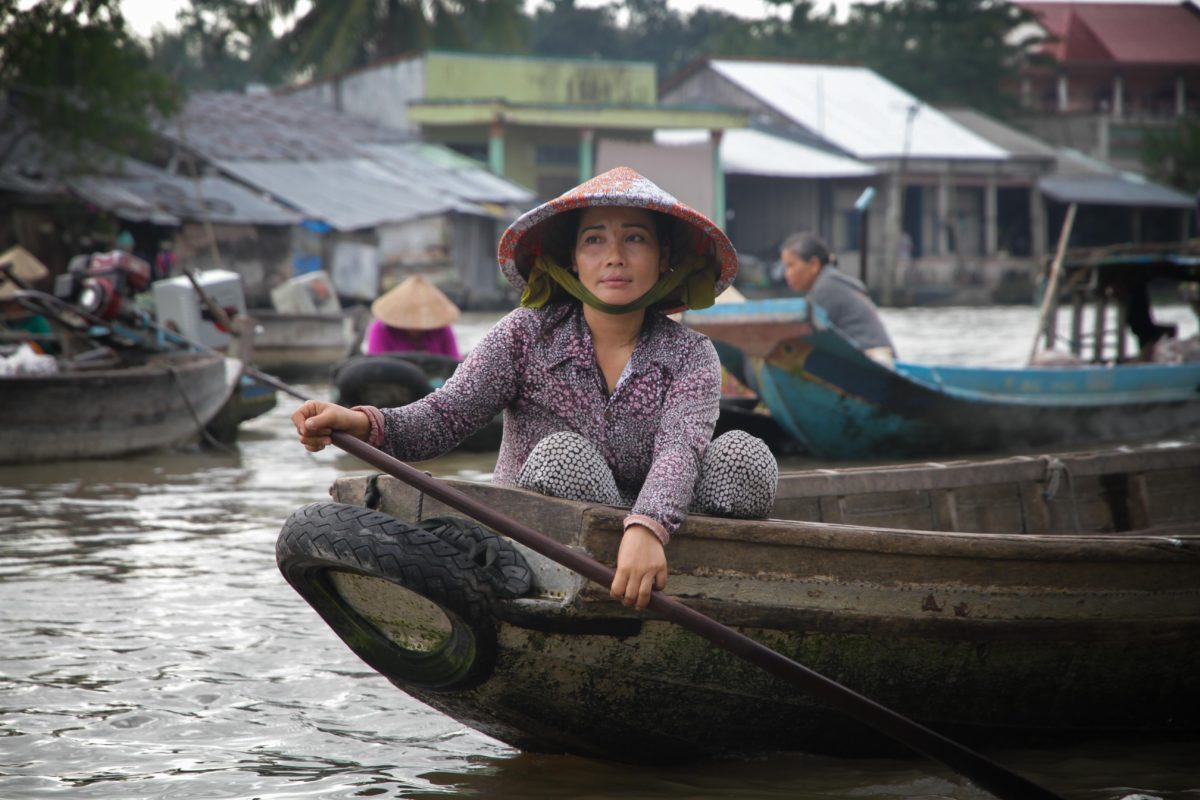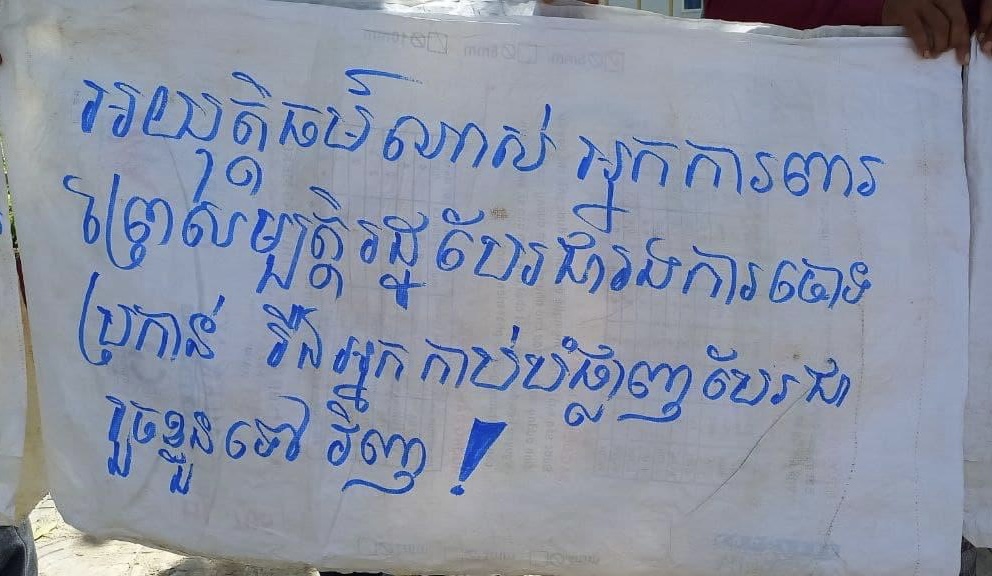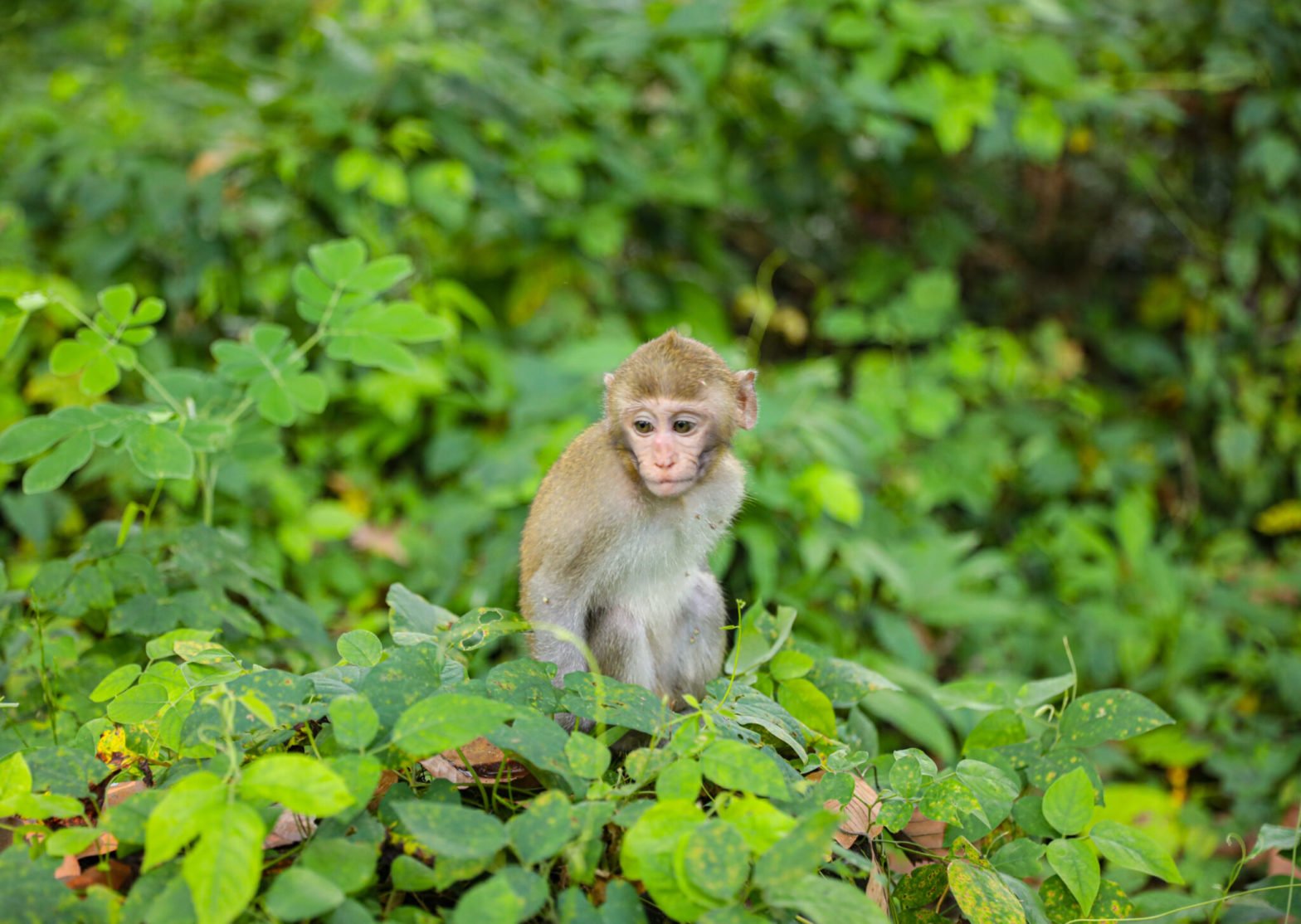The Mekong River in the Vietnamese delta region has consistently received its lowest flow levels in recent years, limiting rice-growing and other crops. Climate change, saline intrusion, and hydropower dams have all significantly impacted farmers’ livelihoods but Resolution 120, a response from the Vietnamese government, is expected to provide some hope for a shift in agricultural strategy and food security for the future.
With more than 30 years of experience in rice farming, Cung Tran from Long Phu district, Soc Trang province in Vietnam’s Mekong Delta, decided not to grow winter rice this year. In recent years, due to lack of fresh water and more saline water in the dry season, he has had to reduce the number of main crops from three to two per year.
He can still vividly remember what happened two years ago. In 2020, all farmers he knew in the region had been left empty-handed when they tried to grow the late winter-spring crop (the third crop of the year). Green rice plants turned to brown. Dry cracked earth was visible next to many fields. Farmers, however, could not do anything but witness their fields dying.
Mekong River losing its mighty flow
In recent years, farmers like Tran have lost their crops in Long Phu district, situated close to the Hau River (also known as the Bassac River in Khmer), an end part of the Mekong River running from Cambodia to Vietnam. And 2020 was the worst year for the farmers because they were not able to access freshwater.
At that time, the Mekong River water level hit its lowest recorded at the Bassac River section flowing through Cambodia’s northeast province of Stung Treng, according to Cambodian authorities and the Mekong River Commission (MRC).
The Stung Treng water level lost the total amount equivalent to more than 60 million Olympic-sized swimming pools during 2020, compared with its average of 421.3 cubic kilometers (km3) across 1910–2008.
The latest MRC report of January 2022, Mekong Low Flow and Drought Conditions in 2019–2021, noted that there are a lot of factors affecting how much water can flow, including worsening climate and unusually low rainfall and upstream hydropower.
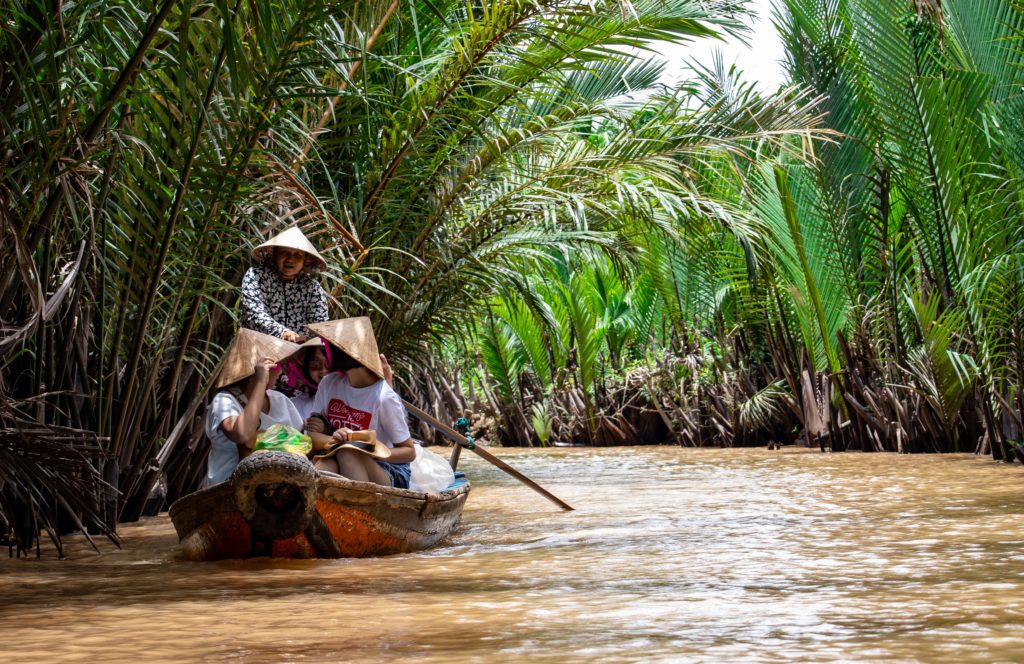
“Since 2008, China’s major dams at Xiaowan and Nuozhadu began to significantly change the Mekong’s flow regime,” said Brian Eyler, Southeast Asia Director of the Stimson Center.
“This leads to five of the top ten lowest flow years, compared to the 1910–2008 baseline average.”
These are the years 2010, 2015, 2019, 2020 and 2021, according to the updated data report from the MRC. The MRC report also concluded that over the last three years, flows on the Mekong mainstream have decreased to levels not seen in more than 60 years.
“Since 2015, the hydrological regime has changed, with more dry season flow and reduced wet season flow caused by increased storage reservoirs in the basin. And the 2019–2021 period was exceptional due to highly reduced rainfall and worsening climate conditions,” the report outlined.
Additionally, the Mekong Dam Monitor, an online platform providing near-real time reporting and data downloads across numerous previously unreported indicators in the Mekong Basin, can give us a clearer picture about what happened during the 2019–2021 period.
“During dry and wet seasons of 2019, the lower Mekong region experienced an unprecedented drought at Chiang Saen, Thailand, because China’s 11 mainstream dams held back enough water to entirely remove the pulse of water that would have come out of China during the 2019 wet season,” noted Eyler from the Stimson Center, the think tank that jointly developed the Mekong Dam Monitor.
“Instead of flows increasing during the wet season as they normally do, flows decreased for the first time ever and the wet season pulse was entirely unobservable in the data.”
Dr. Nguyen Ngoc Huy, Senior Climate Change Advisor of Oxfam in Vietnam, also listed the same main factors for what is happening in the Mekong Delta: climate change, saline intrusion, and hydropower dams.
Moreover, human impacts and interventions have accelerated the natural causes, making things more challenging. In a nutshell, there is not enough water released from the upper Mekong River and as a result, this mighty river has lost its natural flows. In fact, the last time the Mekong River had a natural flood pulse was in the year 2011, Dr. Huy noted.
Economic impacts and domestic agricultural shifting
The Mekong Delta has also witnessed more extreme climate and weather than before. In 2015– 2016, it suffered the worst saline intrusion since 1991 and then again in 2019–2020.
During the severe drought and salinity intrusion in 2015–2016, a lot of provinces suffered damages, such as An Giang, which reduced more than 15% of annual fishery production from 2014–2016. This means nearly one in seven fish disappeared per year during this period.
In an event hosted by the U.S. Mission in Vietnam in November 2021, Dr. Cao Le Quyen, Deputy Director of the Vietnam Institute of Fisheries Economics and Planning under the Ministry of Agriculture and Rural Development (MARD), shared the economic impacts on aquaculture in the Mekong Delta from the two previous saline intrusions.
According to Dr. Quyen, saline intrusion in 2015–2016 damaged 20,000 hectares (5% of total aquaculture areas in Mekong Delta) with 8,716 hectares of aquaculture damaged (1%) in 2019–2020. Ca Mau, Tien Giang, Ben Tre, Kien Giang and Bac Lieu are among the most affected provinces, with tens of thousands of lost species, such as shrimp, mollusk, freshwater carp, and catfish.
According to Vietnam’s General Statistics Office data, between 2001–2021, there was a reverse trend in households participating in fisheries and rice production. Within 10 years, one in five households turned into a fishery farm, but the number of households relying on farming reduced by more than 15%. This indicates 3 in 20 households farming in the Mekong Delta are quitting for some reason.
The latest data also showed the net migration rate in the Mekong Delta in 2019 was –8%. It means the out-migration trend is increasing faster than in-migration, with 2 in every 25 people moving out of the Mekong Delta region in 2019.
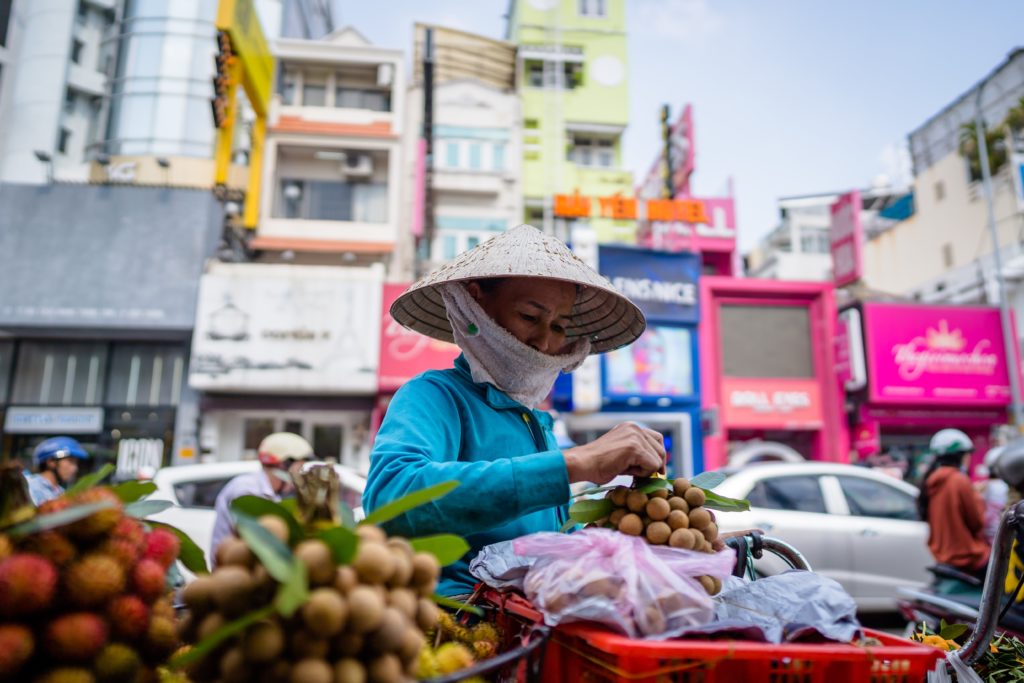
Sustainable path to food security
In Long Phu district, Soc Trang province, local farmers like Tran are not so aware of what is happening beyond their locality, such as the mega-dams in the upper Mekong River or the sea level rising due to global climate change. They make their decisions in farming based on instinct and deep experience, as well as information on saline intrusion and rainfall from the local government.
With three decades experience of growing rice, he noticed that things got worse over the past 7–8 years. Now he has to use more fertilizer but the yield is still bad. For example, in the past he used around 30 kg of fertilizer per 1,000 m2, but now this has increased to 50–60 kg of fertilizer per 1,000 m2. And the cost of fertilizer in 2021 was more than double the year before.
This year, Tran thought carefully before deciding to leave the field to rest for several months after harvesting the autumn-winter crop. He doesn’t want to try – and in the worst case – lose all the crops or dare to rent his field to other farmers.
This decision was made because salt water can destroy the paddy and it would take a lot of time and labor to recover. In recent years, lack of fresh water in the dry season has always been a frequent reality in his region. Sometimes, Long Phu River near his field nearly laid bare its riverbed because there was not enough water.
Tran recalled how people who didn’t have a rice paddy decided to rent one, but then when the rice was dying, they were pushed into debt. After some crops failed, he outlined that for every 10 farmers, there was one person who sold their field to repay debt and move to the city or do something else for a living.
“A lot of people migrate to Binh Duong (30 km away from Ho Chi Minh City) to look for jobs in the factories,” he said.
Nguyen Huu Thien, an independent expert on the Mekong Delta ecology, said an International Union for Conservation of Nature’s (IUCN) survey in 2016 showed that three rice crops per year is too much for some families in Dong Thap province.
There was one family who had to give up their land and “go to Binh Duong” after trying to increase from two to three crops per year. Land nutrition was depleted, farming costs were high, and natural resources were exhausted, according to the IUCN.
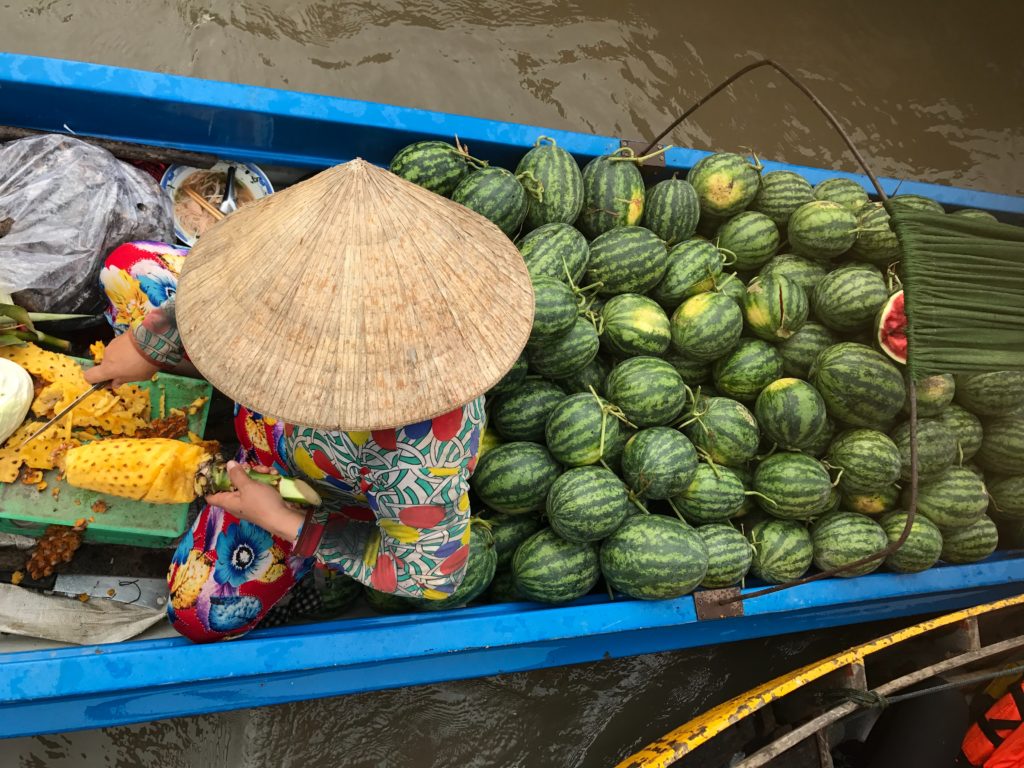
Saline as a resource and the rise of Resolution 120
Based on interviews with experts for this article, they all acknowledged the challenges the Mekong Delta is facing and praised swift actions from the Vietnamese government.
After the region suffered huge losses when severe drought and saline intrusion combined forces at the end of 2015 and early 2016, it took only one year for the government to introduce Resolution 120 on Sustainable and climate-resilient development of the Mekong Delta.
Thien said Resolution 120 has also officially shifted the Vietnamese agricultural focus from a cycle of rice–other crops–aquaculture to fisheries–other crops–rice. Basically, this is a nature-based solution adapted to the Mekong’s real situation to focus on de-intensifying rice production and transitioning into flood-based agriculture.
For his part, Dr. Le Phat Quoi, a regional expert at the Global Environment Center based in Malaysia, suggests reducing from three main crops to two crops per year in order to help the Mekong Delta lands recover.
Besides, farmers should not sell out of straw after cultivation but leave the straw in the fields to return and build up nutrients for the soil. He asks local governments not to be afraid of saline intrusion and prevent natural flow of the river systems by building a lot of dykes and sluices.
“It’s time to consider saline as a natural resource, and raise suitable aquatic species, such as crayfish, shrimp, crab, and so on,” he suggests. “If you want to keep sustainable development, you should focus on solutions to adapt with climate change.
The local governments should find ways to move on with the natural ecosystem in the Mekong Delta, and not interfere with it,” Dr. Quoi added. What he believes should occur is help for the Mekong Delta to buy time, giving the delta areas crucial time to adapt.
Dr. Vo Tong Xuan, the well-known ‘Dr. Rice’ of the Mekong Delta, compares Resolution 120 as the way to remove restrictions hampering rice farmers for so long. The leading and most respected agriculture expert in Vietnam has come up with a solution for the Mekong Delta.
Firstly, reduce the area of rice cultivation in the dry season, especially the low-lying regions (Dong Thap, An Giang, part of Can Tho, Vinh Long). Instead, the farmers can dig deep rainwater ditches to store fresh water and take the soil to build up an area to plant tropical fruit trees with high export value. Groundwater should only be used for daily life activities.
In the dry season, he continued, locals should only grow rice within the so-called ‘food security zone’ which borders Cambodia, such as in Kien Giang, An Giang, Dong Thap, Long An and Tien Giang provinces.
These inland provinces are the first areas to receive fresh water from the Mekong River and keep a secure distance from the sea for saline intrusion. And the coastal provinces can raise more fish or shrimp and whichever species can bring high value to aquaculture farmers.
According to Dr. Xuan, aquaculture not only plays an important part for food security and poverty alleviation in the Mekong Delta, but also can become a powerful source for the Vietnam government’s budget to invest back into rice production.
For their part, the central and local governments need to build up a more complete supporting system for farmers, such as doing research and marketing overseas, introducing valuable and typical products from each province, creating an identity of fruit and aqua products from Vietnam, and acting as a guiding force for locals in planting and raising agricultural products.
In recent years, some western countries such as the U.S. have paid more attention to issues relating to the Mekong River. In a written statement, U.S. Consul General Marie C. Damour agreed that the government of Vietnam has made a great effort to put the resolution into practice, as evidenced by the development of an Action Plan approved in 2019 to implement Resolution 120 on sustainable and climate-resilient development of the Mekong Delta.
Resolution 120 acknowledged that impacts of climate change, with rising sea levels, greater weather variability, and salinization, have become the Mekong Delta’s new normal.
It provided a foundation for transforming the region’s development, from a small household farm and provincial perspective to an inter-provincial, delta-wide, and transboundary one; from a short-term sectoral perspective to a long-term, multisectoral, and integrated approach.
“Resolution 120 shows the Government of Vietnam’s commitment to combating climate change. We are interested to see how Resolution 120 will be implemented in the coming years and appreciate the work Vietnam has put in to move towards sustainability,” according to Damour.
This story was supported by the Mekong Data Journalism Fellowship jointly organized by Internews’ Earth Journalism Network and the East-West Center. It was originally published by Heinrich-Böll-Stiftung on 22 February 2022.


